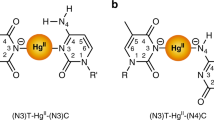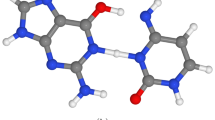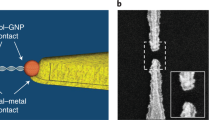Abstract
Charge transport through the DNA double helix is of fundamental interest in chemistry and biochemistry, but also has potential technological applications such as for DNA-based nanoelectronics. For the latter, it is of considerable interest to explore ways to influence or enhance charge transfer. In this Article we demonstrate a new mechanism for DNA charge transport, namely ‘deep-hole transfer’, which involves long-range migration of a hole through low-lying electronic states of the nucleobases. Here, we demonstrate, in a combined experimental and theoretical study, that it is possible to achieve such transfer behaviour by changing the energetics of charge injection. This mechanism leads to an enhancement in transfer rates by up to two orders of magnitude and much weaker distance dependence. This transfer is faster than relaxation to the lowest-energy state, setting this mechanism apart from those previously described. This opens up a new direction to optimize charge transfer in DNA with unprecedented charge-transfer rates.
This is a preview of subscription content, access via your institution
Access options
Subscribe to this journal
Receive 12 print issues and online access
$259.00 per year
only $21.58 per issue
Buy this article
- Purchase on Springer Link
- Instant access to full article PDF
Prices may be subject to local taxes which are calculated during checkout





Similar content being viewed by others
References
Schuster, G. B. (ed.) Topics in Current Chemistry Vols 236 and 237 (Springer, 2004).
Wagenknecht, H. A. Charge Transfer in DNA (Wiley-VCH, 2005).
Genereux, J. C. & Barton, J. K. Mechanisms for DNA charge transport. Chem. Rev. 110, 1642–1662 (2010).
Lewis, F. D. Distance-dependent electronic interactions across DNA base pairs. Charge transport, exciton coupling, and energy transfer. Israel J. Chem. 53, 350–365 (2013).
Kuzuya, A. & Ohya, Y. Nanomechanical molecular devices made of DNA origami. Acc. Chem. Res. 47, 1742–1749 (2014).
Young, R. M. et al. Charge transport across DNA-based three-way junctions. J. Am. Chem. Soc. 137, 5113–5122 (2015).
Xiang, L. et al. Intermediate tunneling-hopping regime in DNA charge transport. Nature Chem. 7, 221–226 (2015).
Murphy, C. J. et al. Long-range photoinduced electron transfer through a DNA helix. Science 262, 1025–1029 (1993).
Kawai, K. & Majima, T. Hole transfer kinetics of DNA. Acc. Chem. Res. 46, 2616–2625 (2013).
Lewis, F. D. et al. Crossover from superexchange to hopping as the mechanism for photoinduced charge transfer in DNA hairpin conjugates. J. Am. Chem. Soc. 128, 791–800 (2006).
Lewis, F. D., Zhu, H., Daublain, P., Cohen, B. & Wasielewski, M. R. Hole mobility in DNA A-tracts. Angew. Chem. Int. Ed. 45, 7982–7985 (2006).
Grozema, F. C. et al. Effect of GC base pairs on charge transfer through DNA hairpins: the importance of electrostatic interactions. J. Am. Chem. Soc. 131, 14204–14205 (2009).
Lewis, F. D., Daublain, P., Cohen, B., Vura-Weis, J. & Wasielewski, M. R. The influence of guanine on DNA hole transport efficiency. Angew. Chem. Int. Ed. 47, 3798–3800 (2008).
Giese, B., Amaudrut, J., Köhler, A.-K., Spormann, M. & Wessely, S. Direct observation of hole transfer through DNA by hopping between adenine bases and by tunnelling. Nature 412, 318–320 (2001).
Liu, C.-S. & Schuster, G. B. Base sequence effects in radical cation migration in duplex DNA: support for the polaron-like hopping model. J. Am. Chem. Soc. 125, 6098–6102 (2003).
Felts, A. K., Pollard, W. T. & Friesner, R. A. Multilevel Redfield treatment of bridge-mediated long-range electron transfer: a mechanism for anomalous distance dependence. J. Phys. Chem. 99, 2929–2940 (1995).
Jortner, J., Bixon, M., Langenbacher, T. & Michel-Beyerle, M. E. Charge transfer and transport in DNA. Proc. Natl Acad. Sci. USA 95, 12759–12765 (1998).
Zhang, Y., Liu, C., Balaeff, A., Skourtis, S. S. & Beratan, D. N. Biological charge transfer via flickering resonance. Proc. Natl Acad. Sci. USA 111, 10049–10054 (2014).
Grozema, F. C. et al. Effect of structural dynamics on charge transfer in DNA hairpins. J. Am. Chem. Soc. 130, 5157–5166 (2008).
Blaustein, G. S., Lewis, F. D. & Burin, A. L. Kinetics of charge separation in poly(A)-poly(T) DNA hairpins. J. Phys. Chem. B 114, 6732–6739 (2010).
Renaud, N., Berlin, Y. A., Lewis, F. D. & Ratner, M. A. Between superexchange and hopping: an intermediate charge-transfer mechanism in poly(A)-poly(T) DNA hairpins. J. Am. Chem. Soc. 135, 3953–3963 (2013).
Lewis, F. D. et al. Driving force dependence of electron transfer dynamics in DNA. J. Am. Chem. Soc. 122, 12346–12351 (2000).
Lewis, F. D., Zhang, L., Kelley, R. F., McCamant, D. & Wasielewski, M. R. A perylenedicarboxamide linker for DNA hairpins. Tetrahedron 63, 3457–3464 (2007).
Singh, A. P. N. et al. Raising the barrier for photoinduced DNA charge injection with a cyclohexyl artificial base pair. Faraday Discuss. 185, 105–120 (2015).
Beljonne, D., Pourtois, G., Ratner, M. A. & Bredas, J. L. Pathways for photoinduced charge separation in DNA hairpins. J. Am. Chem. Soc. 125, 14510–14517 (2003).
Lewis, F. D. et al. DNA-mediated exciton coupling and electron transfer between donor and acceptor stilbenes separated by a variable number of base pairs. J. Am. Chem. Soc. 126, 8206–8215 (2004).
Rogers, J. E. & Kelly, L. A. Nucleic acid oxidation mediated by naphthalene and benzophenone imide and diimide derivatives: consequences for DNA redox chemistry. J. Am. Chem. Soc. 121, 3854–3861 (1999).
Kobayashi, K. Evidence of formation of adenine dimer cation radical in DNA: the importance of adenine base stacking. J. Phys. Chem. B 114, 5600–5604 (2010).
Lewis, F. D., Liu, X., Miller, S. E., Hayes, R. T. & Wasielewski, M. R. Dynamics of electron injection in DNA hairpins. J. Am. Chem. Soc. 124, 11280–11281 (2002).
Harris, M. A. et al. Direct observation of the hole carriers in DNA photoinduced charge transport. J. Am. Chem. Soc. 138, 5491–5494 (2016).
Renaud, N., Berlin, Y. A. & Ratner, M. A. Impact of a single base pair substitution on the charge transfer rate along short DNA hairpins. Proc. Natl Acad. Sci. USA 110, 14867–14871 (2013).
Breuer, H.-P. & Petruccione, F. The Theory of Open Quantum Systems (Oxford Univ. Press, 2007).
Mantz, Y. A., Luigi, G. F., Teodoro, L. & Michele, P. Solvent effects on charge spatial extent in DNA and implications for transfer. Phys. Rev. Lett. 99, 058104 (2007).
Basko, D. M. & Conwell, E. M. Effect of solvation on hole motion in DNA. Phys. Rev. Lett. 88, 098102 (2002).
Voityuk, A. A. Charge transfer in DNA: hole charge is confined to a single base pair due to solvation effects. J. Chem. Phys. 122, 204904 (2005).
Vura-Weis, J., Wasielewski, M. R., Thazhathveetil, A. K. & Lewis, F. D. Efficient charge transport in DNA diblock oligomers J. Am. Chem. Soc. 131, 9722–9727 (2009).
Thazhathveetil, A. K., Trifonov, A., Wasielewski, M. R. & Lewis, F. D. Increasing the speed limit for hole transport in DNA. J. Am. Chem. Soc. 133, 11485–11487 (2011).
Mishra, A. K., Young, R. M., Wasielewski, M. R. & Lewis, F. D. Wirelike charge transport dynamics for DNA–lipid complexes in chloroform. J. Am. Chem. Soc. 136, 15792–15797 (2014).
Young, R. M. D. et al. Ultrafast conformational dynamics of electron transfer in ExBox4+ perylene. J. Phys. Chem. A 117, 12438–12448 (2013).
Brown, K. E., Veldkamp, B. S., Co, D. T. & Wasielewski, M. R. Vibrational dynamics of a perylene–perylenediimide donor–acceptor dyad probed with femtosecond stimulated Raman spectroscopy. J. Phys. Chem. Lett. 3, 2362–2366 (2012).
Acknowledgements
This material is based on work supported by the US Department of Energy, Office of Science, Office of Basic Energy Sciences, Chemical Sciences, Geosciences, and Biosciences Division under award no. DE-FG02-96ER14604 (F.D.L.) and the US Office of Naval Research MURI grant no. N00014-11-1-0729 (M.R.W., Y.A.B. and M.A.R.). The research leading to these results has received funding from the European Research Council FP7 ERC grant agreement no. 240299 and Horizon 2020 ERC grant agreement no. 648433.
Author information
Authors and Affiliations
Contributions
A.P.N.S. and F.D.L. synthesized the DNA hairpins and performed structural characterization. M.A.H. and M.R.W. conceived and performed the transient absorption spectroscopy as well as the global analysis of the results. N.R., Y.A.B., M.A.R. and F.C.G. developed the model and performed the theoretical calculations. N.R., F.D.L. and F.C.G. wrote the paper with contributions from all authors.
Corresponding authors
Ethics declarations
Competing interests
The authors declare no competing financial interests.
Supplementary information
Supplementary information
Supplementary information (PDF 7154 kb)
Rights and permissions
About this article
Cite this article
Renaud, N., Harris, M., Singh, A. et al. Deep-hole transfer leads to ultrafast charge migration in DNA hairpins. Nature Chem 8, 1015–1021 (2016). https://doi.org/10.1038/nchem.2590
Received:
Accepted:
Published:
Issue Date:
DOI: https://doi.org/10.1038/nchem.2590
This article is cited by
-
The optical properties of adenine cation in different oligonucleotides: a PCM/TD-DFT study
Theoretical Chemistry Accounts (2018)
-
Hot holes break the speed limit
Nature Chemistry (2016)



